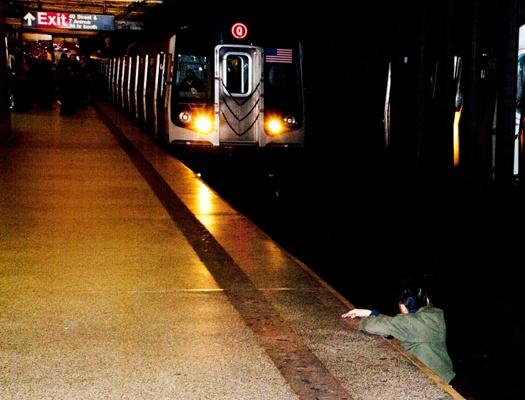Photo by: R. Umar Abbasi
Image Source: http://www.imediaethics.org/News/3640/Clues_that_abbasi_lied_about_new_york_post_subway_photo_.php
Another issue with this image is whether or not the New York Post should have published it. It was very bold to have this image on the front page. The text that is published along with the image is very disrespectful. This image was shown everywhere and I can image that the family of the man that died are not very happy about the image. I think that the image should not have been published on the front page of the New York Post. It is alarming and very personal. I think that the main reason that the New York Post did publish the image is because the image will shock people and the New York Post will sell more issues and become more popular simply because of the image. However, it is an image that the family of the man will have stuck in their heads for the rest of their lives. I do not think it was right to publish this photograph.
Photo by: R. Umar Abbasi
Image Source: http://www.forbes.com/sites/jeffbercovici/2012/12/04/new-york-posts-subway-death-photo-was-it-ethical/
The words expressed in my personal ethics map are humble, honesty, caring, loyalty, faith, trustworthy, and fair. If I was to compare my personal ethics map to this controversial photojournalism ethics situation, I would use the words honesty, caring, and fair. It seems like the photographer did what he could in the moment of time. It was a short amount of time to decide how to save someones life. I think that if I was in the same situation as the photographer, I would try to cause more of a scene to draw attention to the man. I would run over to the man and try to grab him if I could. The word honesty and fair seem to go hand in hand in this situation. If you are honestly trying your hardest to help the person in danger, then there should be no problem. By trying to attract the attention of the driver, you are honestly trying to help. I think that the most important word that relates to this situation is caring. A person must care more for the life of another individual rather than a famous photograph that they can take. A human life must outweigh fame.
Photo By: Lyndsey Letourneau
I do not think that the photographer had much time to think about the situation. I don't think that he purposely took the photograph without regard for the man's life. However, there have been claims about the intentions of the photographer. Some people claim that he did not try to help the man and was trying to get a photograph of the event. One of the problems with this situation is that the photographer claims that he was running towards the man on the platform. However, according to an article posted on imediaethics.org, Abbasi remained in the same spot the entire time. A problem that I noticed with the photograph is the clarity of it. If a photographer was just firing his flash off at the train driver, the image might be blurry and maybe crooked. However, it is impossible to determine what the photographer was truly thinking during this time. It is possible that he just got extremely lucky with shooting without looking and captured the image.



No comments:
Post a Comment